ABSTRACT
Thirty-nine Arabian and Turkish coffee powder samples purchased from various markets in Saudi Arabia were analyzed by High Pure Germanium (HPGe) gamma spectrometry to determine the activity concentrations of the natural and artificial radionuclides 238U, 226Ra, 232Th, 137Cs, and 40K. All samples, (except for two samples of Turkish coffee) were found to contain a high mean content of 40K, ranging from 839.83 to 1197.11 Bq/kg and from 161.312 to 2411.215 Bq/kg for Arabian and Turkish coffee powders, respectively. The concentrations of 226Ra and 232Th were found to be 2.57 to 10.63 Bq/kg and nondetectable to 8.01 Bq/kg for Arabian coffee and nondetectable to 10.09 Bq/kg and nondetectable to 9.75 Bq/kg for Turkish coffee, respectively. Based on these values, we estimated the potential radiological hazards to consumer health from coffee powder. We determined the radium equivalent, annual effective dose rate, and external and internal hazard for each element, and all were found to be below the limit recommended by the United Nations Scientific Committee on the Effects of Atomic Radiation. However, absorbed dose rate values for some samples were higher than the permissible limit. In all samples, the 137Cs concentration was below the detection limit. The average annual committed effective dose values reported in this study were far below the world average value of 0.30 mSv/yr for an individual. In addition, the limit for the threshold consumption rate was calculated. The statistical methods were applied to study the relationship between all the calculated natural radionuclides and their hazard parameters. Results indicated that the use of these types of coffee had no significant radiological health risks. This study may contribute data on coffee powder for formulating regulations related to radiological health care.
Key words: Arabian and Turkish coffees, natural radioactivity, radiological hazard parameters.
Coffee is one of the most popular and widely consumed beverages in the world, and its consumption is increasing (Roselli et al., 2013). However, variation exists in the annual consumption between countries. In addition, coffee is grown in many countries, where the coffee trade has played a crucial role in their economic development (Roselli et al., 2013). Coffee comes from the plant genus Coffea, which has two primary species, C. arabica (Arabica) and C. canephora (also known as C. robusta, or robusta). Some naturally occurring radioisotopes and other elements present in soil are drawn into the roots of plants via ion channels or specific transporters (Sugiyama et al., 2009; Jibiri et al., 2016). Their distribution throughout the plant tissues depends on their chemical characteristics and several parameters of soil and the plants themselves (Awudu, 2012). Several studies have been performed to determine the concentrations of elements in various types of coffee and to estimate whether these concentrations contribute to toxicity (Szymczycha-Madeja et al., 2014; Welna et al., 2014; Jarošová et al., 2014; Zaidi et al., 2005).
Jarošová et al. (2014) determined the toxic elements and mineral nutrients, including Pb, Ni, Mn, Cr, Cd, Zn, Mg, Fe, Cu, and Ca, in five types of coffee by using inductively coupled plasma mass spectrometry (ICP-OES) and atomic absorption spectrometry (AAS). No significant differences were found between the results obtained through the two methods, but a multivariate analysis helped to identify variations among samples collected from different locations. Zaidi et al. (2005) used instrumental neutron activation analysis to measure 20 trace elements (toxic, essential, and nonessential) in samples of coffee beans from four different origins and two instant coffee brands consumed in Pakistan. They next estimated the daily intake of trace elements and compared those levels with tolerance limits. The intake of toxic elements was well below the recommended safety limits, but the cumulative intake of Mn was four times higher than the acceptable amount.
Knowledge of the concentrations and distributions of natural radionuclides, such as 40K, 238U, and 232Th and their decay products, in soils, plants, sediments, and so forth is useful for monitoring environmental radioactive contamination (El-Reefy et al., 2006). Use of chemical fertilizers, especially phosphorus fertilizer, may lead to increased contamination of agricultural crops by enriching the soil with radioactive elements as well as chemical toxins (Alharbi, 2013).
Roselli et al. (2013) determined the background level of gamma emitters, including 212Bi, 212Pb, 228Ac, 214Bi, 214Pb, 40K, and 137Cs, in 18 brands of coffee powder. The mean activity concentration of 40K was found to be 907.4 ± 115.6 Bq/kg. In addition, the mean activity concentration of 214Bi and 214Pb, indicators of 226Ra, given as the mean value of the two radionuclides, resulted in 10.61 ± 4.02 Bq/kg 228Ra. 228Ac indicators showed a mean activity concentration of 13.73 ± 3.20 Bq/kg. 212Pb, a 224Ra indicator, presented a mean activity concentration of 8.28 ± 2.88 Bq/kg. The mean activity concentration of 208Tl, another 224Ra indicator, was 11.03 ± 4.34 Bq/kg. Results indicated that all samples had 137Cs concentrations less than the detection limit (2.0 Bq/kg).
The aim of this study was to compare the concentration of naturally occurring radioactive materials (NORMs) in Arabian and Turkish coffee powder using gamma spectrometry. The imported samples were bought from selected local markets. Additional goals were to determine the radiological hazard associated with drinking coffee made from the various coffee powders and to estimate the average annual committed effective dose via ingestion of the radionuclides in the coffee and the threshold consumption rate.
The study focused on coffee powder to enrich the radiological information in Saudi Arabia in particular and the world in general because information on the concentration of NORMs and their presence in coffee is scarce.
Thirty-nine coffee powder samples were purchased at different markets in Saudi Arabia. Each powdered was grinded and dissolved as homogenous solution and weighing about 200 to 250 g. The samples were then transferred to polyethylene 650-mL Marinelli type beakers (of known weight) were hermetically sealed with an insulating tape to impede contact with air moisture say labeled, and packed into radon-impermeable plastic containers to prevent radon gas escape as much as possible. Containers of the same size and geometry were used for reference materials to calibrate the system for measuring radioactivity. The samples and reference materials were stored and kept for a period of 1 month to attain secular radioactive equilibrium among 226Ra, 232Th, and their respective short-lived decay products 226Ra and its decay products in the uranium series and 228Ra and its decay products in the thorium series (Kurnaz et al., 2007; Samad et al., 2012). Finally, each Marinelli container was analyzed using a HPGe detector.
The radiometric measurement
Detection of the amount of natural radioactivity for 226Ra, 238U, 232Th, and 40K in coffee powder samples was carried out with gamma spectrometry using a high-purity germanium (HPGe) detector (P-type vertical coaxial, Canberra model GC4018). The detector had 25% relative efficiency and a resolution of 1.85 at 1332 keV of 60Co gamma ray. The gamma acquisition and analysis were determined by using a multichannel analyzer (16,000 channels spectral memory) coupled to a computer using Genie-2000 Basic Spectroscopy Software. Quality-assured standard samples in QCY4 solution (obtained from the International Atomic Energy Agency) were used for the calibration and the absolute efficiency of the detector. The mixture of radionuclides in the solution (with corresponding energies) included 60Co (1173 and 1333 keV), 88Yt (898 and 1836 keV), 137Cs (662 keV), 85Sr (514 keV), 113Sn (391.69 keV), 203Hg (279 keV), 139Ce (1656 keV), 57Co (122 keV), 109Cd (88 keV), and 241Am (60 keV). Detailed information concerning calibration of the HPGe detector and the procedures followed can be found in previous study (Tufail et al., 2006; Fawzia, 2010). To measure the environmental gamma background, an empty identical Marinelli beaker was used. All samples and the background were counted for 36,000 s. After measurement, the activity concentrations were calculated by subtraction of the background values. The 137Cs and 40K concentrations were measured by determining their characteristic gamma lines of energies, 661.6 and 1460.8 keV, respectively. The 226Ra activity concentration was determined by averaging the calculated activity concentrations of three photopeaks of 214Bi (1764.5, 1120.3, and 609.3 keV) and two of 214Pb (295.1 and 352 keV). The activity of 232Th was inferred from the weighted mean activities of the gamma peaks of 208Tl (583.0 keV), 212Pb (238.6 keV), and 228Ac (911.2 and 338.4 keV). In addition, the activity of 238U was given by the line of gamma of its product decay: 234Th (63.22 and 92.78 keV) (Darko, 2015). The minimum detectable activity concentrations of 40K, 238U, 232Th, 226Ra, and 137Cs using HPGe detector were 2.51, 1.0, 0.80, 0.75, and 0.85 Bq/kg, respectively.
Calculations
Absorbed dose rate and annual effective dose rate equivalent from ingestion of coffee powder
According to United Nations Scientific Committee on the Effects of Atomic Radiation (UNSCEAR, 2010), the external outdoor absorbed gamma dose rate (D) from natural radionuclides in the samples under study (at 1 m above the ground level) can be calculated from the following equation:
Where, ARa, ATh, and AK are the activity concentrations of radium, thorium, and potassium, respectively. The absorbed dose can be converted to the annual effective dose equivalent by using the conversion factor 0.7 Sv/Gy (UNSCEAR,2000) and the indoor occupancy factor of 0.8, based on people spending an average of 80% of their time indoors and 20% outdoors (Jibiri, 2016).
The total annual effective dose (AE, the external dose rates) from the 226Ra, 232Th, and 40K is obtained by using the following equation (Giri, 2013):
The absorbed dose rate (D) and the annual effective dose (AE) for the coffee powder samples are presented in Table 4.
The radium equivalent
The radium equivalent activity for coffee powder is given by the following equation (Matiullah et al., 2004):
Equation 3 compares the activity concentrations of coffee powder containing different amounts of 40K, 232Th, and 226Ra. The permissible limit of this index is 370 Bq/kg as reported by UNSCEAR (2000).
The internal and external hazard indices
The internal and external exposures to gamma radiation in coffee powder were determined using the Equations 4 and 5, respectively (Fawzia, 2010):
To safely consume the coffee powder, the upper limit for both the internal index (Hin) and the external index (Hex) should be less than unity as reported by ICRP (2007).
Average annual committed effective dose or dose ingested by the consumer
Estimation of the average annual committed effective dose (AACED) due to ingestion of NORMs in coffee can be calculated using the following equation (Njinga et al., 2015; Chandrashekara and Somashekarappa, 2016):
where, Eave (Sv/yr) is the AACED, Ai is the activity concentration of each radionuclide i , Cr is the consumption rate of radionuclide, and DCFi is the standard dose conversion factor (2.8 × 10−4, 2.3 × 10−4, and 6.2 × 10−6 mSv/Bq for 226Ra, 232Th, and 40K, respectively, for an adult) (UNSCEAR, 2000). The annual threshold consumption rate (kg/yr) for each coffee sample was obtained using the following equation:
Where, A1, A2, and A3 are the activity concentrations of 226Ra, 232Th, and 40K, respectively DCF1, DCF2, and DCF3 are the dose coefficients for ingestion for the radionuclides (Sv/Bq) and Eave = 0.3 (mSv/yr) is the threshold AACED due of NORMs in the studied samples.
The activity concentrations of 40K, 238U, 226Ra, and 232Th in Arabian and Turkish coffee powders imported for Saudi markets from different countries were estimated, and the results are summarized in Tables 1 and 2, respectively. As shown in Table 1, the activity concentrations of 226Ra and 232Th varied from 2.57 to 10.63 Bq/kg with a mean value 6.19 Bq/kg and from nondetectable (ND) to 8.01 Bq/kg with a mean value 4.31 Bq/kg, respectively. In addition, as shown in Table 2, the activity concentrations of 226Ra and 232Th ranged from ND to 10.09 Bq/kg with a mean of 2.77 Bq/kg and ND to 9.75 Bq/kg with a mean of 3.12 Bq/kg, respectively. All these values are significantly lower than the permissible levels reported by UNSCEAR (2010) (33 and 45 Bq/kg for 226Ra and 232Th, respectively), as shown in Figures 1 and 2. The activity concentrations of 40K in Arabian coffee powder ranged from 839.83 to 1197.11 Bq/kg with a mean value of 1041.24 Bq/kg. Sample CA5 had the highest activity concentration, while sample CA9 had the lowest value. For Turkish coffee powder samples, the activity concentrations of 40K varied from 161.31 to 2411.22 Bq/kg with a mean of 1507.18 Bq/kg. The lowest activity was recorded for sample CT20, while the highest activity was recorded for sample CT24. With the exception of two Turkish samples CT20 and CT21, all Arabian and Turkish coffee powders had 40K concentrations that were higher than the acceptable value (412 Bq/kg) (UNSCEAR, 2010). Based on Figure 3, the mean activity concentrations of 40K in Arabian and Turkish coffee powders are 1.53 and 2.69 times higher than the recommended limit, respectively. In addition, the 40K concentration was 46.28% higher in the Turkish coffee than in the Arabian coffee. Moreover, the current results from Arabian and Turkish coffee powders showed a mean concentration of 40K that was higher than that obtained by Roselli et al. (2013), although the mean concentration of 226Ra was within the range found in the same study. This finding may be linked to contaminated soils in the farming areas (Fatima et al., 2008; Faanu et al., 2016). Uranium 238 was detectible in all study samples except samples CA10, CA11, CT2, CT15, CT20, CT21, and CT22. The highest 238U concentrations were found in sample CA5 (135.11 Bq/kg) and sample CT10 (57.16 Bq/kg), representing Arabian and Turkish coffee powders, respectively.
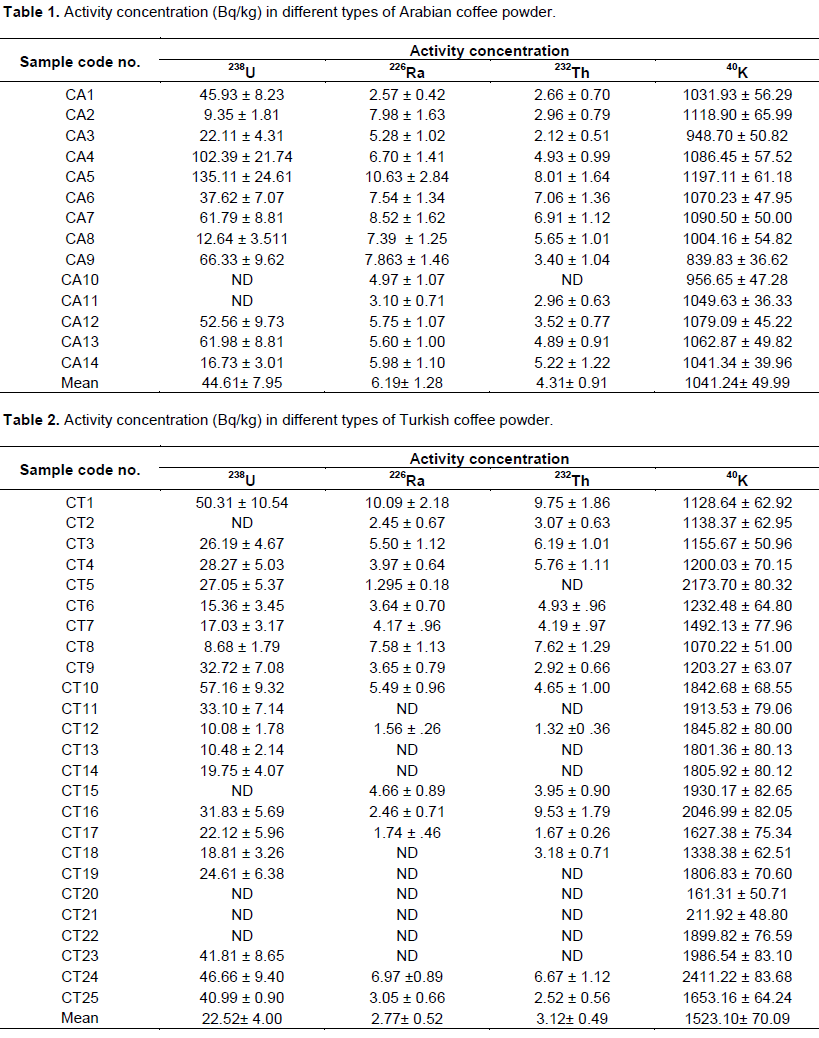

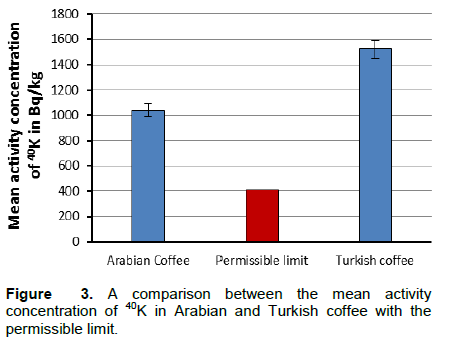
Hence, the mean activity concentration of 238U in Arabian coffee was approximately 98.09% higher than the Turkish coffee. The activity concentration of 232U ranged from ND to 66.33 Bq/kg with a mean value of 44.61 Bq/kg for Arabian coffee powder and from ND to 57.16 Bq/kg with a mean value of 22.52 Bq/kg. Figure 4 shows a comparison of 238U in Arabian and Turkish coffee powders, in which the mean activity in Arabian samples is less than the permissible limit, but the mean activity in Turkish samples was 35.18% higher than the acceptable limit. The measurements show that all studied samples had concentrations of the artificially produced radionuclide 137Cs below the detectable limit except in samples CA5 and CT19, which had the values of 3.44 and 1.26 Bq/kg, respectively.
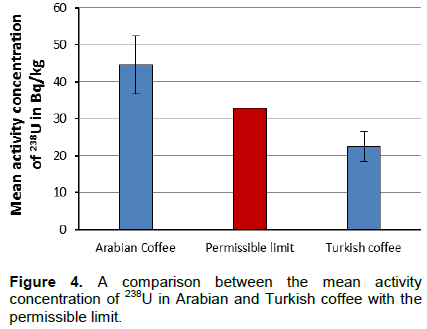
Tables 3 and 4 list the calculated values of the radium equivalent, absorbed dose rate, annual effective dose rate, and gamma hazard indices Hex and Hin used in Equations 1 to 5, respectively. The results showed that the radium equivalent lay in the ranges of 77.382 to 114.254 Bq/kg (CA9 and CA5, respectively) for Arabian coffee powder with a mean value 90.595 Bq/kg and from 12.421 to 202.159 Bq/kg for Turkish coffee powder with a mean value of 124.586 Bq/kg. These values are less than the permitted limit of 370 Bq/kg. The estimated values for the absorbed dose rate in Arabian and Turkish coffee powders varied from 40.703 to 59.665 nGy/h (CA9 and CA5, respectively) with a mean value of 48.655 nGy/h and from 6.727 to 107.791 nGy/h (CT20 and CT24, respectively) with a mean value of 66.709 nGy/h. According to UNSCEAR (2010), all results fell below the recommended limit for the average exposure rate (84 nGy/h). External and internal hazards were also determined based on Equations 4 and 5. Tables 5 and 6 show that the external and internal hazard indexed are less than unity for Arabian and Turkish coffee powders. With a unit consumption rate of 1 kg per annum being used, the AACED due to the ingestion of radionuclides 232Th, 226Ra, and 40K from Arabian and Turkish coffee was estimated using Equation 6, and the results are presented in Tables 5 and 6. The AACED varied from 0.00232 to 0.00396 mSv/yr and from 0.00032 to 0.00598 mSv/yr for Arabian and Turkish coffee powders, respectively. The mean values of AACED in the study samples were far below the world AACED of 0.3 mSv/yr for ingestion of natural radionuclides detailed in UNSCEAR (2010).
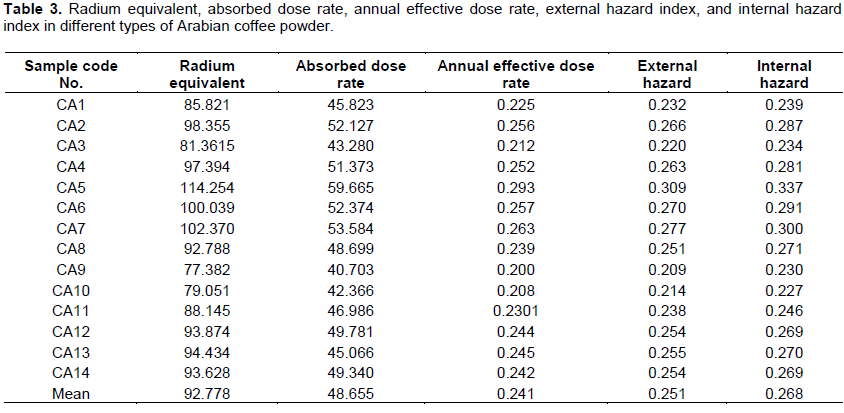
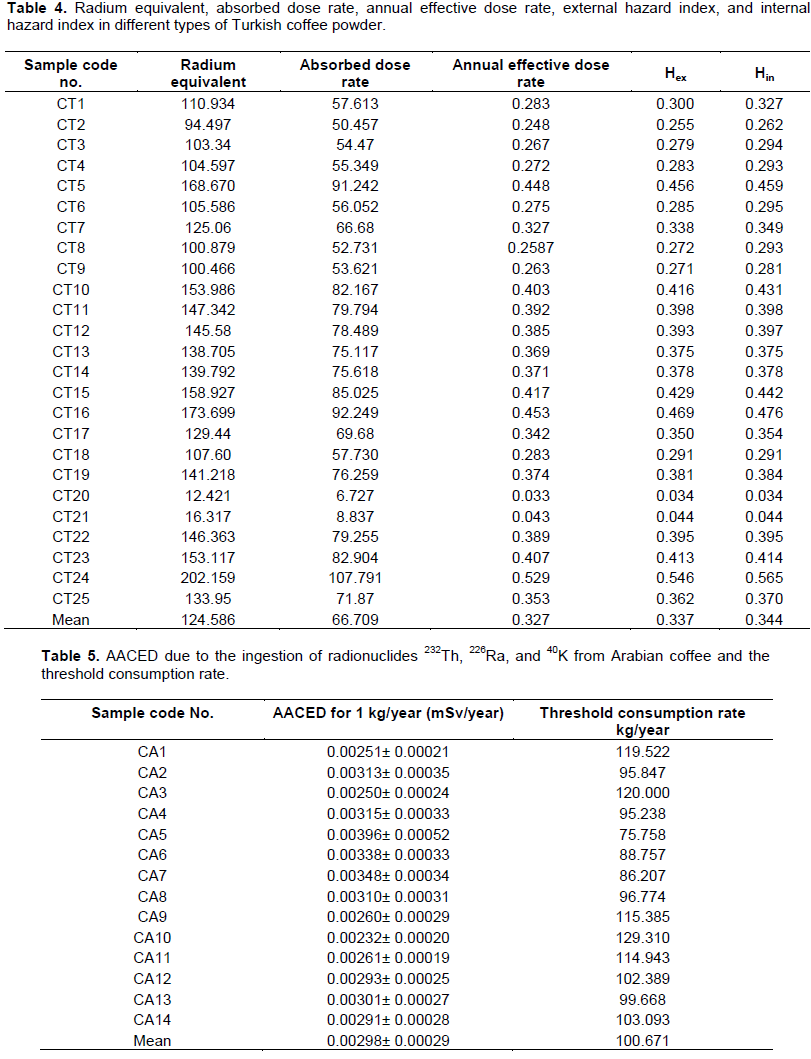
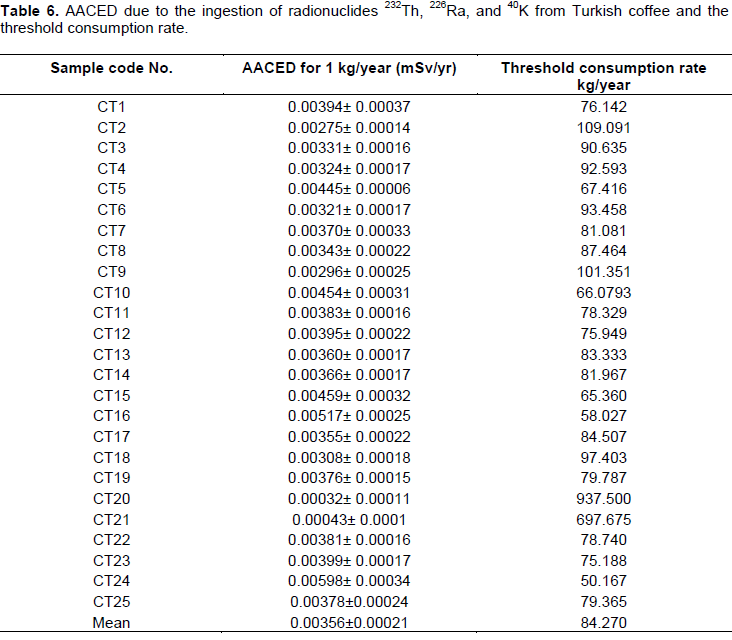
The highest AACED value for Arabian coffee powder was associated with sample CA5 because of the high activity concentrations of 232Th, 226Ra, and 40K, while sample CA10 had the lowest AACED value. As shown in Tables 2 and 6, sample CT24 had the highest AACED value for Turkish coffee powder because of the high activity concentration of 40K, while sample CT20 had the lowest value owing to the low activity concentrations of 232Th, 226Ra, and 40K. Figure 5 presents the AAECD as a function of various consumption rates within the range of 0 to 100 kg/year.
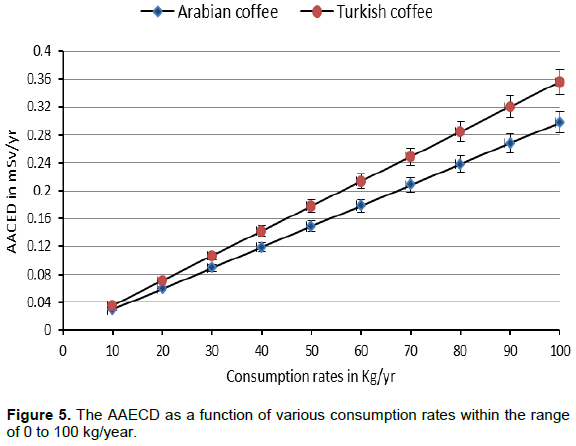
The threshold consumption rate (Table 5 and 6) is the amount at which the AACED value exceeds 0.3 mSv for any of the coffee powders. Consequently, Tables 5 and 6 provide baseline data indicating that an individual with a consumption rate below the threshold values would experience an insignificant radiological health risk, but someone with a consumption rate that is slightly higher than the threshold values faces significant radiological health risk.
Statistical analysis
Descriptive statistics
Basic descriptive statistics were used to characterize the central tendency and variation of the data. The distribution of radionuclides measured in Arabian and Turkish coffees and the radiological hazards using SPSS, version16.0 for Windows (Sivakumar et al., 2014). Figures 6 and 7 shows the distribution of radionuclides (226Ra, 232Th, 40K, and 238U) with respect to sample code numbers in the Arabian and Turkish coffee. Tables 7 and 8 summarize the statistical parameters such as minimum, maximum, arithmetic mean, standard deviation, skewness, and kurtosis. The asymmetry of the probability distribution for real values of random variables can be characterized by measuring the degree of skewness. A normal distribution has a skewness of zero. Therefore, positive (or negative) skewness indicates a distribution with an asymmetric tail extending towards values that are more positive (or negative) (Adam and Eltayeb, 2012). The radionuclides in Arabian and Turkish coffees (Tables 7 and 8) have positive skewness values, indicating that the distributions are asymmetric, with the exceptions of 40K, 232Th, and 226Ra in Arabian coffee and 40K in Turkish coffee.
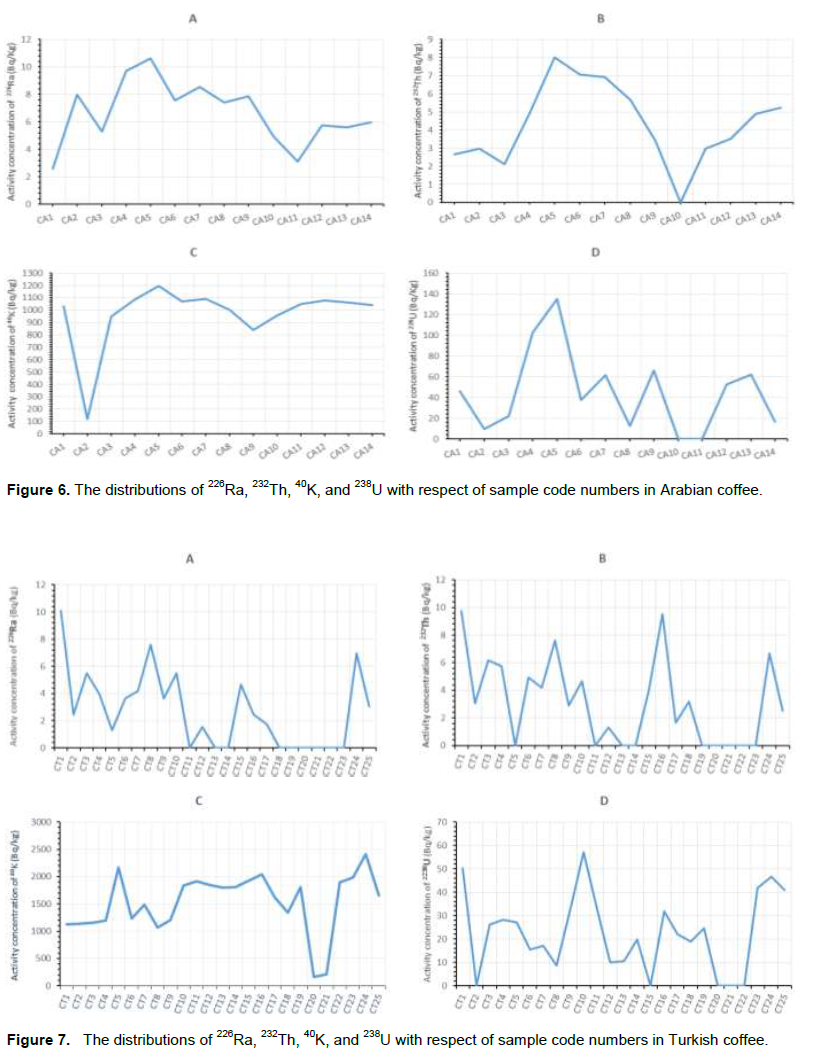
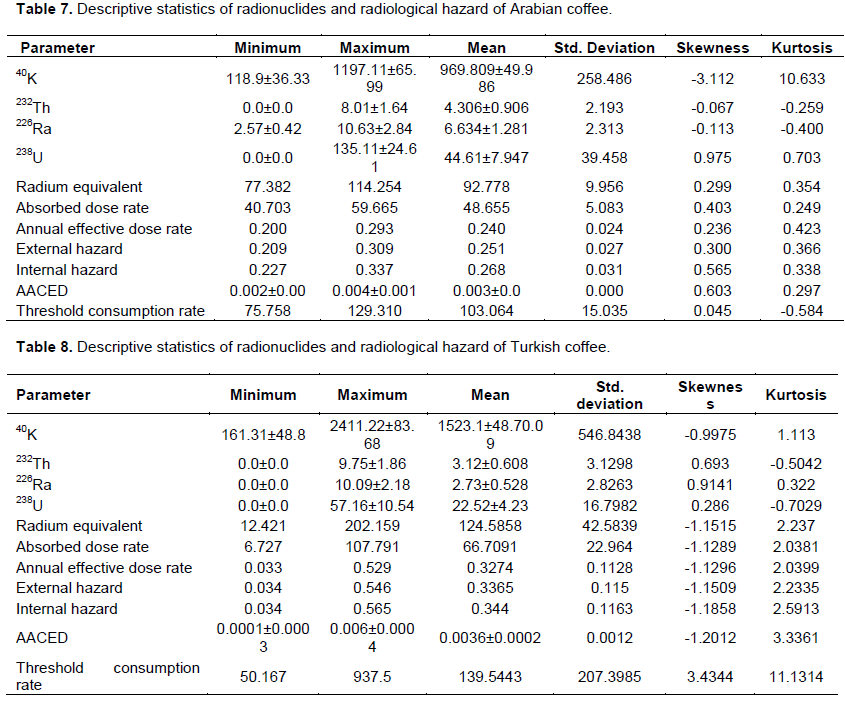
Kurtosisis determined if the distributions for data are peaked or flat relative to a normal distribution. Positive kurtosis indicates a relatively peaked distribution, while negative kurtosis indicates a relatively flat distribution. Higher kurtosis means that more of the variance is explained by infrequent extreme deviations, as opposed to frequent slight deviations (Raghu et al., 2015). According to Tables 7 and 8, the distributions associated with 40K and 238U in Arabian coffee and for 40K and 226Ra in Turkish coffee have positive kurtosis values, indicating peaked distributions, and the others radionuclides have negative kurtosis values, indicating flat distributions.
Frequency distribution
To estimate the probability distribution of continuous variables the histograms are represented in Figure 8A to D) for Arabian coffee and in Figure 9A to D for Turkish coffee. The frequency distributions (according to the normality test for Shapiro-Wilk) for all activity concentrations in Arabian and Turkish coffees were analyzed (Tanaskovi et al., 2012). The graphs in Figure 8 show that the 40K was distributed in non-normal distribution, while the 238U, 232Th, and 226Ra were distributed in a normal (bell-shaped) distribution in Arabian coffee. All radionuclides in Turkish coffee were distributed in non-normal distribution except 238U as shown in Figure 9.
Pearson’s correlation analyses
Pearson’s correlation analyses were performed to determine the interrelation between the natural radionuclides and the calculated radiological hazard parameters (Liu et al., 2003). The obtained correlation coefficients are presented in Tables 9 and 10. Positive correlations were observed between 226Ra and 283U with 232Th in Arabian coffee, and also between 283U and 226Ra in Turkish coffee, but, it is less severe than it is in Arabic coffee. From the earlier stated observations, 226Ra series and 232Th series are usually found together in nature. Hence, these radionuclides contribute to the emission of gamma radiation in all regions. Positive correlations existed among of the most hazard parameters and 232Th, 226Ra, and 238U in Arabian coffee. In addition, a strong correlation was observed between hazard parameters and 40K and weak correlation between them and 238U in Turkish coffee. Moreover, strong correlations among most of the radiological hazard parameters were noted and each other.
In this study, measurement of radioactivity in Arabian and Turkish coffee powders sold in Saudi Arabia markets wasperformed. The 40K, 232Th, 226Ra, and 238U concentrations were comparable with those reported elsewhere. The mean 40K activity concentrations in Turkish coffee were greater than those in Arabian coffee, and both were higher than the allowable value. The mean 238U activity concentrations in Arabian coffee were greater than in Turkish coffee, but both were ​​less than the permissible limit. In addition, the mean activities of 232Th and 226Ra in Arabian and Turkish coffee powders were much less than the recommended limit. To assess the radiological risk, the mean values of the radium equivalent, absorbed dose rate, annual effective dose rate, Hex, and Hin were estimated, and all were less than the allowable limits reported by UNSCEAR (2010). The results specified for all samples under study are far below the AACED limit (0.3 mSv/year for individual) provided by UNSCEAR (2010). Thus, these results indicate that the radiological risk related to drinking coffee is insignificant. Coffee shop workers may face a greater health hazard because they experience external exposure to potentially large amounts of coffee powder and may thus accumulate large doses.
The annual effective ingestion dose from coffee should be added to the total global dose from food consumption. The data obtained from this research provides information on the activity concentration of natural radionuclides and increases the knowledge about natural radioactivity. The statistical analysis also confirms that these samples under the study of Arabian and Turkish coffees do not possess significant gamma radiation effects. Coffee quality must be strictly controlled, and the study of radionuclide concentration in this matrix has great significance. In terms of the coffee market, determining the radioactivity values of the commodity is important for customers.
The authors have not declared any conflict of interests.
REFERENCES
|
Adam AMA, Eltayeb MAH (2012). Multivariate statistical analysis of radioactive variables in two phosphate ores from Sudan. J. Environ. Radioact.107:23-43.
Crossref
|
|
|
|
Alharbi WR (2013). Natural radioactivity and dose assessment for brands of chemical and organic fertilizers used in Saudi Arabia. J. Modern Phys. 4:344-348.
Crossref
|
|
|
|
Awudu AR, Faanu A, Darko EO, Emi-Reynolds G, Adukpo OK, Kpeglo DO, Otoo F, Lawluvi H, Kpodzro R, Ali ID, Obeng MK, Agyeman B (2012). Preliminary studies on 226Ra, 228Ra, 228Th and 40K concentrations in foodstuffs consumed by inhabitants of Accra metropolitan area, Ghana. J. Radioanal. Nucl. Chem. 291:635-641.
Crossref
|
|
|
|
Chandrashekara K, Somashekarappa HM (2016). Estimation of radionuclides concentration and average annual committed effective dose due to ingestion for some selected medicinal plants of South India. J. Radiat. Res. Appl. Sci. 9:68-77.
Crossref
|
|
|
|
Darko G, Faanu A, Akoto O, Acheampong A, Goode EJ, Gyamfi O (2015). Distribution of natural and artificial radioactivity in soils, water and tuber crops. Environ. Monit. Assess. 187(6):339.
Crossref
|
|
|
|
El-Reefy HI, Sharshar T, Zaghloul R, Badran HM (2006). Distribution of gamma-ray emitting radionuclides in the environment of Burullus Lake: I. Soils and vegetations. J. Environ. Radioactivity 87(2):148-169.
Crossref
|
|
|
|
Faanu A, Adukpo OK, Tettey-Larbi L, Lawluvi H, Kpeglo DO, Darko EO, Emi-Reynolds G, Awudu RA, Kansaana C, Amoah PA, Efa AO, Ibrahim AD, Agyeman B, Kpodzro R, Agyeman L (2016). Natural radioactivity levels in soils, rocks and water at a mining concession of Perseus gold mine and surrounding towns in Central Region of Ghana. SpringerPlus 5:98.
Crossref
|
|
|
|
Fatima I, Zaidi JH, Arif M, Daud M, Ahmad SA, Tahir SNA (2008), Measurement of natural radioactivity and dose rate assessment of terrestrial gamma radiation in the soil of southern Punjab, Pakistan. Radiat. Prot. Dosimet. 128(2):206-212.
Crossref
|
|
|
|
Fawzia A (2010). External and internal radiation exposure of herbal plants used in Egypt. Radiat. Eff. Defects Solids 165:65-71.
Crossref
|
|
|
|
Giri S, Jha VN, Singh G, Tripathi RM (2013). Estimation of annual effective dose due to ingestion of natural radionuclides in foodstuffs and water at a proposed uranium mining site in India. Int. J. Radiat. Biol. 89:1071-1078.
Crossref
|
|
|
|
ICRP(2007): The Recommendations of the International Commission on Radiological Protection. ICRP Publication 103. Ann. ICRP. 37.
|
|
|
|
Jarošová M, Milde D, Kuba M (2014). Elemental analysis of coffee: a comparison of ICP-MS and AAS methods. Czech. J. Food Sci. 32:354-359.
|
|
|
|
Jibiri NN, Isinkaye MO, Bello IA, Olaniyi PG (2016). Dose assessments from the measured radioactivity in soil, rock, clay, sediment and food crop samples of an elevated radiation area in south-western Nigeria. Environ. Earth Sci. 75:107.
Crossref
|
|
|
|
Kurnaz A, KüçükömeroÄŸlu B, Keser R, Okumusoglu NT, Korkmaz F, Karahan G, Cevik U (2007). Determination of radioactivity levels and hazards of soil and sediment samples in Firtina Valley (Rize, Turkey). Appl. Radiat. Isotopes 65:1281-1289.
Crossref
|
|
|
|
Liu WX, Li XD, Shen ZD, Wang DC, Wai OWH, Li YS (2003). Multivariate statistical study of heavy metal enrichment in sediments of the Pearl River Estuary, Environ. Pollut.121: 377–388.
Crossref
|
|
|
|
Matiullah, Ahad A, ur Rehman S, Faheem M (2004). Measurement of radioactivity in the soil of Bahawalpur division, Pakistan. Radiat. Prot. Dosimet. 112:443-447.
Crossref
|
|
|
|
Njinga RL, Jonah SA, Gomina M (2015). Preliminary investigation of naturally occurring radionuclides in some traditional medicinal plants used in Nigeria. J. Radiat. Res. Appl. Sci. 8:208-215.
Crossref
|
|
|
|
Raghu Y, Ravisankar R, Chandrasekaran A, Vijayagopal P, Venkatraman B (2015). Assessment of natural radioactivity and radiological hazards in building materials used in the Tiruvannamalai District, Tamilnadu,India, using a statistical approach. J. Taibah Univ. Sci.
Crossref
|
|
|
|
Roselli C, Desideri D, Rongoni A, Saetta D, Feduzi L (2013). Radioactivity in coffee. J. Radioanal. Nucl. Chem 295:1813-1818.
Crossref
|
|
|
|
Samad MA, Ali MI, Paul D, Islam SMA (2012). Assessment of radiological significance of the wastes generated from the triple super phosphate (TSP) fertilizer factory, Chittagong, Bangladesh. J. Bangl. Acad. Sci. 36:79–88.
Crossref
|
|
|
|
Sivakumar S, Chandrasekaran A, Ravisankar R, Ravikumar SM, Prince Prakash Jebakumar J, Vijayagopal P, Vijayalakshmi I, Jose MT (2014). Measurement of natural radioactivity and evaluation of radiation hazards in coastal sediments of east coast of Tamilnadu using statistical approach. J. Taibah Univ. Sci. 8:375384.
Crossref
|
|
|
|
Sugiyama H, Terada H, Isomura K, Iijima I, Kobayashi J, Kitamura K (2009). Internal exposure to 210Po and 40K from ingestion of cooked daily foodstuffs for adults in Japanese cities. J. Toxicol. Sci. 34:417-425.
Crossref
|
|
|
|
Szymczycha-Madeja A, Welna M, Pohl P (2014). Fast method of elements determination in slim coffees by ICP OES. Food Chem. 146:220-225.
Crossref
|
|
|
|
Tanaskovi I, Golobocanin D, Milijevic N (2012). Multivariate statistical analysis of hydrochemical and radiological data of Serbian spa waters. J. Geochem. Expl. 112:226-234.
Crossref
|
|
|
|
Tufail M, Akhtar N, Waqas M (2006). Measurement of terrestrial radiation for assessment of gamma dose from cultivated and barren saline soils of Faisalabad in Pakistan. Radiat. Meas. 41:443-451.
Crossref
|
|
|
|
United Nations Scientific Committee on the Effects of Atomic Radiation (UNSCEAR) (2010). Sources and effects of ionizing radiation. Report to the General Assembly with Scientific Annexes, United Nations, New York P 1.
|
|
|
|
United Nations Scientific Committee on the Effects of Atomic Radiation (UNSCEAR) (2000). Sources, effects and risks of ionizing radiation. Report to the General Assembly with Annex B. United Nations, New York
|
|
|
|
Welna M, Szymczycha-Madeja A, Pohl P (2014). Improvement of determination of trace amounts of arsenic and selenium in slim coffee products by HG-ICP-OES. Food Anal. Methods 7:1016-1023.
Crossref
|
|
|
|
Zaidi JH, Fatima I, Arif M, Qureshi IH (2005). Determination of trace elements in coffee beans and instant coffee of various origins by INAA. J. Radioanal. Nucl. Chem. 267:109-112.
Crossref
|